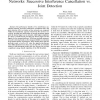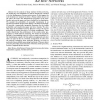97 search results - page 8 / 20 » Bounding the power rate function of wireless ad hoc networks |
ICC
2009
IEEE
14 years 2 months ago
2009
IEEE
Abstract—The performance benefits of two interference cancellation methods, successive interference cancellation (SIC) and joint detection (JD), in wireless ad hoc networks are ...
CORR
2007
Springer
13 years 7 months ago
2007
Springer
—In the analysis of large random wireless networks, the underlying node distribution is almost ubiquitously assumed to be the homogeneous Poisson point process. In this paper, th...
ISCC
2003
IEEE
14 years 25 days ago
2003
IEEE
In previous work, we thoroughly studied the intricate problem of energy conservation in wireless ad hoc networks. Consequently, we proposed a novel framework, namely Quasi-Guarante...
INFOCOM
2008
IEEE
14 years 1 months ago
2008
IEEE
—We present the first unified modeling framework for the computation of the throughput capacity of random wireless ad hoc networks in which information is disseminated by means...
MOBIHOC
2004
ACM
14 years 7 months ago
2004
ACM
We propose several novel localized algorithms to construct energy efficient routing structures for homogeneous wireless ad hoc networks, where all nodes have same maximum transmis...


